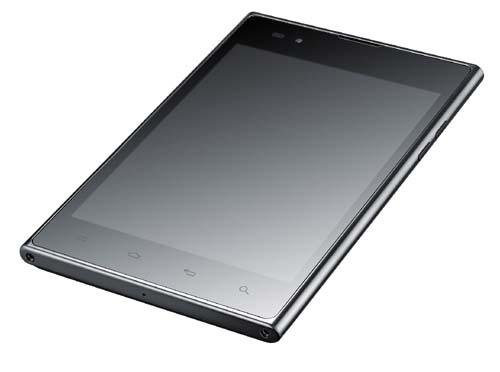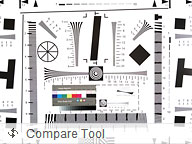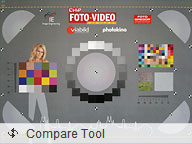The LG Vu pairs the big screen with a handy stylus to enhance tasks like note taking, something that can be a chore on a normal thumb-operated handset.

The dedicated Notebook app lets you create elaborate, multiple-page notes with images and text, or you can just hit the QuickMemo key, which snaps a screenshot and lets you scribble on it - you can screenshot a website, a part of an email, a document, an image, and just about anything else.

This makes the Optimus Vu a handy tool for putting down reminders or helping you communicate with others - it's much easier to explain what you need when you can take a screenshot and sketch your idea over it. Once you're done, sending the image via email, Dropbox, a social network or another channel is just a tap away.

The phoneblet sure has a lot going for it, but it's not all sunshine and roses - you can go ahead and copy our notes on where it scores and where it misses.

Key features
- Dual-band CDMA, 1x EV-DO, HSDPA and LTE connectivity
- 5" 16M-color capacitive HD-IPS LCD touchscreen of XGA resolution (768 x 1024 pixels)
- LG Rubberdium stylus and QuickMemo button
- Android OS v2.3 Gingerbread
- Dual-core 1.5GHz ARM Snapdragon processor, 1GB of RAM, Adreno 220 GPU, Qualcomm MSM8660 Snapdragon chipset
- 32GB of inbuilt storage
- 8 MP autofocus camera, face detection and geotagging
- 1080p @ 30fps video recording
- Front facing 1.3MP camera, video calling
- Wi-Fi b/g/n and DLNA, Wi-Fi Direct, Wi-Fi hotspot
- NFC connectivity
- GPS with A-GPS
- microUSB port (charging)
- Stereo Bluetooth v3.0
- MHL TV-out
- Polaris Office document editor
- Smart dialing, voice dialing
- Accelerometer and proximity sensor
- DivX/XviD video support
- Standard 3.5 mm audio jack
- Dolby Mobile and SRS sound enhancement
- Stereo FM radio with RDS
- T-DMB TV tuner
Main disadvantages
- microSIM cards only
- Runs older Android 2.3 Gingerbread
- Wide form factor needs getting used to
- 4:3 aspect ratio not a good fit for video watching
- No microSD card slot
With a rich app package, the Optimus Vu has solid business credentials. It features the Polaris Office document editor and an app that can automate backups (with an option to encrypt them).
You also get an NFC app, with which you can easily share your contact details, web site, memos, scheduling info and more. You can share it directly with another NFC-enabled device or write the info to NFC tags that you can hand out to people.
The extensive connectivity options go on - you get fast data connections over LTE, Wi-Fi b/g/n, Bluetooth 3.0 and Wi-Fi Direct, then there's the fun stuff like DLNA and a T-DMB TV tuner (ok, that's a Korea-only feature).
We're not counting on the LG Optimus Vu being very pocketable, but we'll be putting the screen under a microscope (even literally) to find out if it's worth the tradeoff. We'll also look at the rest of the hardware and rummage through the retail box - all that's coming up.
Design and build quality
The LG Optimus Vu borrows its design from the LG Prada 3.0 - it's clean cut and angular, with the same rounded metallic sides and patterned plastic back. If you liked the aesthetics of the Prada 3.0, you'll like the Vu too.
The proportions have changed, however. An outfit tailored for the Prada won't fit the Vu as the large 5" 4:3 screen makes the device look more like a small tablet than an oversized phone.
Continuing our tour around the Vu, above the screen, we find proximity and light sensors, and a 1.3MP front-facing camera for video calling.
The LG Optimus Vu's top side is a busy place. We have the 3.5mm audio jack, the QuickMemo button (we'll get back to it in the software chapters), the Power/Lock button, and the microUSB port (which is hidden under a sliding cover). It's actually an MHL port, so with the right adaptor you can use it for TV-out or as a USB host for external USB devices.
The Power/Lock glows when you unlock the device, but doesn't do so on a pending notification.
The secondary mic is also here along with something you often see on South Korean phones - a telescopic antenna. It's there to pick up T-DMB TV signal and it won't make it outside Korea. It's just that our review unit comes straight from the mothership and is a sample of what they have on the Korean market.
New UI on old Android
At first glance, the LG Optimus Vu user interface looks very much like what we saw on the ICS-running Optimus 4X HD but we did find quite a few differences. And unlike the 4X, the Optimus Vu hides Android 2.3 Gingerbread beneath its colorful custom skin.
So, you'll be missing out on some of Ice Cream Sandwich's usability enhancements (things like the new task switcher, the notifications that can be dismissed individually, etc.), but LG has baked into this Gingerbread a good deal of its own improvements. An ICS update is in the pipeline for the Vu but it's too early to tell whether it will get Jelly Bean.
While it's not Android's latest and greatest, everything works just fine - check out this video to get a feel for the LG Optimus Vu in action.
LG is using a custom lockscreen instead of the stock Android variety, but it's not the one from the 4X HD. It offers a clock with two timezones, visible battery charge info and a shortcut for the dialer.


Using a phone lockscreen on a phoneblet
We feel they could have done more with all the room available - weather info, stock info, a news widget, anything to fill up all that real estate. Also, the ability to pull down the notification area to check new notifications is one of the perks of Ice Cream Sandwich that the Vu is missing out on (for now, anyway).
Getting past the lockscreen reveals the homescreen. You get five shortcuts at the bottom of the screen, which are always visible on all homescreen panes and even in the app drawer: Phone, Contacts, Notebook, Messages and Applications.
You can customize the first four of these shortcuts, the fifth one is always Applications/Home. You can put folders in here too.



The homescreen
Adding stuff to the homescreen works quite differently than in stock Android. A tabbed interface lets you pick between Widgets, Shortcuts, Folders and Wallpapers. You can pick an item in the selected category and drag it out from the drawer (the drawer gets out of the way once you start dragging.




Placing widgets and changing the wallpaper
A pinch zoom gesture on the homescreen brings out the familiar overview mode. From here you can rearrange homescreen panes, select the default one and delete unneeded ones. You can add panes, but no more than 7.


Managing homescreen panes
One interesting feature on the Optimus Vu custom UI is that if you press and hold on a shortcut but leave it in place, a small paintbrush icon appears in its corner. If you tap that, you can choose another icon for that shortcut from a predefined list. There's no way to use external icon files, though.


You can change a shortcut's icon
The notification area features a number of toggles - Sound, Wi-Fi, Bluetooth, GPS, Data, NFC and Screen Auto Rotation. You can tap them to toggle the related feature on or off, but you can also press and hold on them to get to the relevant page in the Settings. As usual, if you're playing something in the music player, quick controls will show up here.

The notification area features plenty of toggles
The task switcher shows the 8 most recently used apps. There's an app manager button that brings out the task manager with info on each app (CPU and RAM usage). Apps can be terminated one by one or all at once.


The task switcher has a button to launch the task manager
The app drawer has three view modes - page, category and list view. The paged view is scrolled horizontally and you can rearrange shortcuts. Category view should be familiar to LG users - it organizes applications into categories (e.g. Communication, Multimedia, etc.) A pinch zoom gesture lets you manage categories - rearrange them, add new one or delete ones you've added.




The app drawer has three view modes
There's an option to pick a different theme for the homescreen. There are a total of four preinstalled and they change the wallpaper and the look of the icons but not the functionality.
Another cool thing is the Home Selector - if you decide to install a third party launcher (or ten of them) this little app will help you pick which one shows up when you hit the home key.
Overall, LG has added a few interesting features, but there were still a few things we missed that other custom Gingerbreads UIs offer. Hopefully, when LG updates the Optimus Vu to Ice Cream Sandwich, it will enable the extra enhancements that the 4X HD got.
Tabbed phonebook
The Phonebook has a tabbed interface, in which the third tab lists all contacts alphabetically. Contact images, where available, are displayed and there's a quick alphabet scroll on the right. There's also a regular search bar on top of the contacts list. The other tabs are Dial, Call log and Groups.
Filters keep the phonebook from getting messy - you can choose which groups are displayed and which are hidden (e.g. Family, email contacts, Twitter contacts and so on). The list can be sorted by first or last name and you can choose how contacts are displayed - First Name, Last Name or the other way around.
Quick contacts are available (tap the contact photo to get call, message, email and so on buttons) but LG has used the extra width of the Optimus Vu to include inline buttons for calling and texting contacts, which are even quicker.



Contact display and sort setting
Tapping on the name of a single contact brings up their details. This interface is tabbed too - Info holds the basic contact information, but you can also check call history between you and the contact along with SNS updates and photos from their Facebook account. The Agenda shows events involving that person.




Viewing a single contact
Editing a contact is pretty straightforward; you can add or remove fields as needed, as well as specify the types of phone numbers, email addresses, ringtones and even add notes.
Each phone number and email address field has inline call/message keys, which comes in handy when there are multiple numbers and emails.


Editing a contact
Voice and video telephony
The LG Optimus Vu may not have the most comfortable form factor for calling but it does feature full voice and video calling functionality. It also had no trouble holding on to signal even in areas of spotty coverage and the in-call audio is consistently good too.
The Dialer integrates with the rest of the phonebook. It features smart dialing and will show the matching contact (it matches both names and phone numbers) with an added downwards arrow if there are more than one.
The Call log is clever and groups some of the calls, e.g. 3 missed calls from the same contact on the same day. A number next to the contact name shows the number of events. It's a great space saving feature.



The Call log • Smart dialing
During a call you can pop-up the dialer should you need to dial another number. Also you can use the phone while on a call, just hit the menu key and a small green line replaces the notification area and acts like a shortcut back to the call.


Call notification* In-call screen
We also ran our traditional loudspeaker test on the LG Optimus Vu. It scored a Good result, so you probably won't be missing many calls with it.
| Speakerphone test |
Voice, dB |
Pink noise/ Music, dB |
Ringing phone, dB |
Overal score |
| Samsung Galaxy Nexus |
66.2 |
60.5 |
69.0 |
Below Average |
| Samsung Galaxy Note |
62.9 |
61.7 |
68.0 |
Below Average |
| Apple iPhone 4S |
65.8 |
64.5 |
74.6 |
Average |
| HTC One X |
61.1 |
66.0 |
75.8 |
Average |
| Samsnug Galaxy Tab 7.7 |
69.1 |
66.6 |
75.7 |
Average |
| LG Optimus Vu |
66.2 |
66.6 |
80.7 |
Good |
| Apple iPad 3 |
66.7 |
67.0 |
77.7 |
Good |
| Samsung Galaxy S III |
75.1 |
66.5 |
75.0 |
Good |
| HTC Desire |
76.6 |
75.7 |
84.6 |
Excellent |
Messaging fights spam, schedules texts
The LG Optimus Vu does all common message types: SMS, MMS and email. SMS and MMS are handled through the tabbed Message app. By default it shows you conversation mode, but the other tabs let you view the Inbox, Outbox and Saved messages.



The messaging app • Blocking spam messages
You can customize how messages are kept - all of them or up to some user selectable limit (the default is 300 SMS and 100 MMS). There's also a Spam message box with fairly sophisticated settings at your disposal for blocking spam.
A press-and-hold on the text box gives you access to functions such as cut, copy and paste. You are free to paste the copied text across applications like email, notes, chats, etc. Another cool feature is that the volume rocker controls the text size.




Editing a message* The attach dialog and contextual menu
One cool and potentially very useful feature of the Optimus Vu is the reserved message - you can compose a message and schedule it to be sent out automatically at some point in the future, from within an hour to several months. There are quite a few situations where this could come in handy, for example, making sure you don't forget to send a "Happy birthday" note to someone.
Gmail is part of the core Android experience. It has an optimized interface and can handle multiple Gmail accounts. The extended Gmail features include batch operations, which allow multiple emails to be archived, labeled or deleted, spam report and of course conversation-style email view mode.




The Gmail app
The generic email client supports multiple accounts, and operates in much the same fashion as the Gmail one. If you need to manage multiple accounts (even from different services), the Combined Inbox feature will come in handy, although it has no conversation-style view like in Gmail.




The generic Email client
QWERTY keyboard that can shrink
The LG Optimus Vu offers a standard QWERTY keyboard, which features both portrait and landscape orientation.



The QWERTY keyboards
The keyboard has plenty of room on the screen in portrait orientation, which makes for fast two thumb typing. If you prefer typing with just one hand, LG has you covered - swipe the keyboard left or right to reduce its width by 30% and dock it to the left or right side of the screen respectively. The swipe gesture can be set to change the input mode instead.
Other input options include handwriting recognition (it handled even our poor penmanship) and a 3x4 keypad for old-school multi-tap texting (we're not sure why LG kept this option).


Other input options.
Straightforward gallery
Viewing photos is one of Optimus Vu's strong suits - the large 4:3 screen fits photos with no black bars. That and the good viewing angles mean the Vu can successfully double as a photo frame. It relies on the standard Gingerbread gallery - it automatically locates images and videos no matter where they are stored in the phone's storage.


The Gingerbread gallery
Once selected, you can view an image close up by pinch zooming or double tapping on the desired area. There are plenty of sharing options (from Gmail through messages to NFC) and also simple editing options (crop and rotate).



Gallery options
Media Home is an app that tries to turn the Optimus Vu into a highly functional digital photo frame - it offers big, easy to hit buttons for videos, photos and music. It's easy to start a slideshow or play some music and better still, the app can be set to launch automatically when you put the Vu in a dock or insert an MHL cable.




Media Home app takes care of photo frame duties
If you really want to show off, then you'll need the Video Producer. You choose on of the several predefined styles, add your photos and videos, throw in a soundtrack and you have a colorful, dynamic presentation on your hands.
You can fine tune it too - rearrange photos and clips, add captions and album art to each slide. When you're done, you can export your creation as a video (720p, D1 or QVGA).




Video Producer is an easy way to create great looking photo and video slideshows
Music player does not have the look
The music player is not exactly pretty but it gets the job done. The usual filtering by album and artist is enabled and you have alphabet search and regular search for locating songs quicker. The music player is DLNA-enabled too.



The music player
The Now playing interface places a big album art image in the center with controls above and below it. Swiping the album art left or right is the easiest way to skip songs back and forth.
A press and hold on the album art will bring up a search menu, if you need to look up the title, artist or the album. After that you can pick where to search - your music collection, YouTube or a general Internet search.
There are equalizer presets which become available when you plug in a pair of headphones. Dolby Mobile becomes available only then, too.



The Now Playing screen* The Search feature* Equalizers
When you're playing a song you get music controls on the lockscreen. They are hidden in a sort of notification area style panel that you need to drag down.


Music controls in the lockscreen
Decent audio quality
The LG Optimus Vu did way better than the disappointing LG Optimus 4X HD in our audio quality test. It's not that the phoneblet is perfect, but it should do just fine for most of the users.
When connected to active external amplifier the LG Optimus Vu achieved some pretty good scores for signal-to-noise, dynamic range and stereo crosstalk. The intermodulation distortion was rather mediocre and the extreme bass frequencies have been cut off, but the harmonic distortion was kept well under control. The volume levels were rather low, so we'd call this an average performance.
The good news is there's surprisingly little distortion when headphones come into play. The stereo crosstalk spikes by more than the average amount, but all the other readings remain virtually unaffected. It's certainly the better part of the Vu output.
Capable video player, wrong aspect ratio
The video player has a fairly simple interface, giving you just a list (with thumbs) of all the videos on the device. There's an alphabet scroll to help users locate videos faster but that's about it. You can of course play videos from the Gallery if you prefer its folder-centric organization.
To get the basics out of the way, the available controls during playback include a scrubber for jumping to various parts of the video along with the standard play/pause and skip buttons. There's a Dolby Mobile toggle as well.



The video player
The LG Optimus Vu handled everything we threw at it - DivX, XviD, MKV and MP4/MOV up to, and including, Full HD. The AC3 and DTS audio codecs are supported (those often cause problems on mobile devices), so you don't have to worry about sound compatibility issues either.
Subtitles are supported with settings for font, color, font and size. You can toggle subtitles on and off, but there's no option to manually point to a subtitle file, so the subtitle filename has to match the video filename.
The 4:3 1024x768 screen may not be perfect for 16:9 videos, but even with black borders, the screen is pretty big. On the upside, you can always stream the video over DLNA or better yet hook it up to an HDTV over MHL.
Good 8MP camera
The LG Optimus Vu comes with an 8 megapixel camera, capable of capturing 3264 x 2448 resolution images. There is a single LED flash, but it won't be of much help in most low-light situations.
We found the user interface to be quite convenient, though many of the important settings are inside the extended settings menu, so they take a while to toggle.
From the viewfinder you have access to the front/back camera toggle, digital zoom control, exposure compensation and flash mode. The extended settings let you adjust things like resolution, face detection, geotagging, ISO, white balance, self timer, scene and shot modes (the last two really should have been made available on the top level in the viewfinder).




The camera interface
While there is no hardwired shutter key, pressing the volume keys will snap a photo (either one works). It's not such a good idea though. First, the volume keys don't obviously have half press and second, it's hard to comfortably hold such a wide phone. Of course, there's the virtual on-screen shutter button as well.
Photos from the Optimus Vu have quite a bit of noise in them and the post processing algorithms that try to suppress it wipe out a good deal of fine detail and there are signs of oversharpening. There's still decent detail left, the colors are accurate and the Vu renders shadows well. Photos look at least as good as those coming from an Optimus 4X HD.
Here are a few sample shots we've taken with the LG Optimus Vu.






LG Optimus Vu camera samples
Photo quality comparison
The LG Optimus Vu joins the long list of tested devices in our photo comparison tool. The page of the tool has information on how to use it.
The LG Optimus Vu doesn't perform as well on our synthetic resolution chart as the Optimus 4X HD, but at least it doesn't have that huge pink spot. Noise reduction is less aggressive and leaves the grass and gravel squares in the second chart in fairly good standing. Under artificial lighting, there's a slight blue tint to the photos.


LG Optimus Vu in our Photo Compare Tool
Video camera uses too much compression
The Optimus Vu's camera is capable of shooting 1080p videos at 30fps. The camcorder has the exact same settings available on the viewfinder as the still camera. From the extended settings menu you get a few more - resolution, white balance and color effects.
Videos are recorded in MP4 files with a bitrate of 10Mbps, which isn't enough for FullHD. The framerate is stable at 29fps, but a lot of the fine detail is lost to compression. Colors are okay, but the whole scene gets overexposed. That and the continuous autofocus doesn't know when to stop hunting.
Sound is recorded in stereo, with a sampling rate of 48 kHz and 155Kbps bitrate.


The camcorder UI
Video quality comparison
Compression artifacts are visible across the frame, but the Optimus Vu still manages to keep decent amounts of fine detail. When the lights go out, the situation isn't very flattering - everything becomes very dark and most detail is lost. The final chart shows that there's strong sharpening going on, but again no pink spot unlike the Optimus 4X HD.


LG Optimus Vu in our Video Compare Tool
Connectivity
The LG Optimus Vu is quite adept at connectivity. The version we're reviewing has CDMA and EV-DO, HSDPA and LTE. Of course, other variants will probably drop the CDMA connectivity but LG is stingy on details for non-Korean versions of the Vu.
Anyway, there's plenty of other connectivity features - Wi-Fi b/g/n with DLNA and Wi-Fi Direct, Bluetooth 3.0+HS, NFC and MHL. Then there's the T-DMB tuner too, but that's only of interest to Korean users as this standard is not as popular in other countries. It's not to be confused with the more widely available in Europe DVB-T digital TV broadcasting standard.
SmartShare is an app that lets you control a DLNA network - you can play media from other devices (e.g. NAS) on your phone or play something from the phone onto another device (e.g. a DLNA-enabled TV).
The Wi-Fi Direct is a technology, which enables devices to connect to each other without the need for a Wi-Fi hotspot. The beauty of it is in that only one device has to be Wi-Fi Direct-ready for the magic to happen.
Using this technology two (or up to eight) devices can share files in a more advanced, fast and secure way, paving the road to the eventual demise of Bluetooth for short-range file transfers.




SmartShare* Wi-Fi Direct settings
NFC is also on board in the form of a dedicated app called LG Tag+. With it you can create tags that enable Wi-Fi, GPS, control sound and so on. Just pick your setting, hit write on tag and tap the Optimus Vu on an empty tag.



The LG Tag+ app
There's another NFC app called simply NFC. With it you can share info instead of creating tags, which automate actions. With it you can share a contact, URL, text, a message, trigger a cal or add an event to the other phone's calendar.
Any info you've shared that way is stored for quick access within the application so you can share it again later without having to do it from scratch. The app will also keep a log of tags you've read with the Optimus Vu.
By the way, there are two ways to share info - the first is to share, say a contact, directly with another device and the other is to write the info on an NFC tag that can be later read by other devices.




The NFC app is the go to place for sharing info over NFC or writing that info on tags
We're not done yet - the LG Optimus Vu features an MHL port too - that means you can hook it up to an HDTV to watch movies or photos on the large screen or use a different adapter to enable USB host mode.
Gingerbread browser still has it
The web browser on the Optimus Vu has received some tweaks by LG. The auto-hiding URL bar is on top and has the refresh and bookmark buttons. The bottom control bar houses the back and forward keys, the tab switcher key, and the new tab key. The whole bar auto-hides, leaving only an arrow in the bottom right corner that can be used to bring it back.




The Optimus Vu web browser
When you open a new tab, the screen is populated with the 12 most visited sites, similar to how Firefox or Google Chrome work. A 3D card interface can be used to switch between the open tabs, though you can drop the eye candy and use a simple list.
The browser has Read it later functionality - it's an easy way to mark pages that you want to look at later. That doesn't download an offline copy of the page though, you'll still need internet access. Also, we found no way to sign into Read it later, so we assume it's just a coincidence of names and not the popular service (that was recently renamed Pocket).
The Optimus Vu supports double tap and pinch zoom. There's text reflow too - it adjusts the columns of text to fit the screen width. If you've pinched to zoom in, you need to double tap the screen to make the browser reflow the text.
The dual-core hardware enables the Optimus Vu browser to play 720p Flash videos but 1080p proved too much for it. You can play touch-optimized Flash games too.


Playing YouTube videos and Flash games
Chock-full of organizer features
The Optimus Vu comes with a respectable set of organizing features. We start off with the Office document editor.
The app in question is Polaris Office and it's one of the most advanced mobile editors we've seen. You can of course view documents - Word, Excel and PowerPoint documents and PDF files too. The app lets you add files as favorites or use a two pane file explorer (think Windows Explorer) with support for bulk actions.






The Polaris Office app
Edit mode offers almost a full set of options - text style, justification, paragraph formatting, bullets, even creating tables. If you're editing an Excel file, you get a formula wizard, resize rows/columns, border style, cell merging and so on. Even creating a full PowerPoint presentation is possible.
The Calendar has a tabbed interface so you can easily switch between Month, Week, Day and Agenda views. The app can sync with multiple online calendars and gives you an option to hide the ones you don't want (but keep or turn off syncing for them).



The calendar
Date finder is a useful tool that tells you what date it will be after several days (or what date it was that many days in the past). It makes checking the date a hundred days from now a breeze.
The LG Optimus Vu features an alarm clock application, which allows a lot of alarms to be set, each with its own start and repeat time. The Timer, World Clock and Stopwatch features are also part of this app.




The Alarm* World clock* Stopwatch
The organizer package also includes a useful voice recorder and a nicely touch-optimized calculator. The Memo app allows you to take notes and add media to them, such as images, audio, or location.




The Voice recorder and Calculator • The Memo app
There are also news and weather apps. Both come from Yahoo.


Weather app* News
The so-called QuickMemo function is integrated in the phone's OS, allowing you to capture screen shots of anything (including the lockscreen!) using the dedicated key and scribble notes over them like you would on the LG Optimus 4X HD or the Galaxy Note.
The Vu comes with a comfortable stylus. As you draw, you can pick between different pen styles and colors and an eraser. You can choose to discard the screenshot if you just want to scribble something on an empty background.
When you're done, you can easily share the image or save it to the gallery.
Finally, there is an option to lock the capacitive keys on the front to prevent accidentally getting out of the app before you're done editing.



The QuickMemo function in action
There's another app that uses the stylus - it's called Notebook. It creates "notebooks" with different covers, different page styles (lined, graph, blank) and paper color. Each notebook can have different pages and you can insert regular text, images, videos, locations, dates and memos to complement your sketches.




The Notebook app can do tons more than a plain paper notepad
You have access to several "pen types" (including a spray paint can) and you can change color, thickness and opacity. If you want to draw some really fine detail, you can pull out a magnifying glass from the bottom that gives you a zoomed in view. You can change the zoom and move the magnifying glass around.
The Backup that comes preinstalled on the LG Optimus Vu can backup both pre-installed and downloaded apps, bookmarks, calendar, contacts and call log, messages, how you've arranged your homescreen and your system settings. You can do both manual and scheduled backups.



The Backup app can backup anything and do it on a schedule too
LG Readers is the preinstalled eBook reader on the Vu. The 4:3 aspect ratio is good for reading. The Readers app has a built-in store where you can buy new books.


LG Readers app
Google Play has the apps
The Google Play app market, previously known as the Android Market, lets you download various apps for your device. Upon launch of the Market app you're greeted with the tiled interface of the Featured window. A swipe to the right takes you to the Categories view.




The Google Play market
Swiping to the left takes you through Top Paid, Top Free, Top Grossing, Top New Paid, Top New Free and Trending (the ones with growing popularity).
Downloads are easy and won't take more than a couple of seconds. Before you agree to download an app, the Market will show you what features the app requires access to (e.g. Internet connectivity, access to the file system, etc.). You can also see whether updates are available for your currently installed apps by going to My Apps in the contextual menu.
Google Maps
The LG Optimus Vu managed to get a GPS lock in under a minute without A-GPS. A-GPS can speed up the lock (but it involves some cellular data traffic). Cell-ID and Wi-Fi positioning are also available if all you need is a rough location, but they need a data connection too.
Google Maps is a standard part of the Android package and we've covered it many times before. It offers voice-guided navigation in certain countries and falls back to a list of instructions elsewhere. You can plan routes, search for nearby POI and go into the always cool Street View.




Google Maps
The latest version uses vector maps, which are very data efficient and easy to cache. The app will reroute you if you get off course, even without a data connection.
3D buildings are shown for some of the bigger cities and you can use two-finger camera tilt and rotate to get a better view of the area.
SUMMARY
The LG Optimus Vu is certainly an unusual device - some might see this as an advantage, but there are ergonomic reasons why phones aren't this wide. But the Vu isn't a phone, is it?
While not quite a full-blown tablet, the 4:3 aspect ratio of the screen is actually an advantage when taking notes or just drawing something using the stylus - 16:9 is popular with videos, not notepads or printed media.
It all revolves around the stylus - the Optimus Vu is a fine upper-mid-range device in terms of performance, screen and camera, but it's the stylus and accompanying software that carve out its niche.
SOURCE